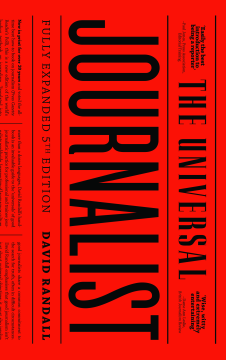
Additional Information
Book Details
Abstract
A new edition of one of the world's leading textbooks on journalism. Translated into more than a dozen languages, David Randall's handbook is an invaluable guide to the 'universals' of good journalistic practice for professional and trainee journalists worldwide.
Randall emphasises that good journalism isn't just about universal objectives: it must also involve the acquisition of a range of skills that will empower journalists to operate in an industry where ownership, technology and information are constantly changing. His acclaimed account challenges old attitudes and rejects cynical, sloppy journalism.
The updated fifth edition ensures its relevance to contemporary readers by addressing issues such as problems of 'de-skilling' in the media and new tools for digital research.
'Easily the best introduction to being a reporter I have come across ... written by a true newsman and his enthusiasm for the task in hand is evident on every page'
Paul Jones, course leader, Press Association Editorial Training
'What I admire about this book is that it is not simply a 'How to' manual, it is also a wise, witty and extremely entertaining read. Anyone who aspires to be a journalist - in any of the media - should read Randall'
Dame Ann Leslie, British Journalism Review
'With lots of handy tips and anecdotes that aptly illustrate the points being made, it is a must-read for all budding student journalists'
Sue Featherstone, principal lecturer in Journalism, Sheffield Hallam University
Table of Contents
| Section Title | Page | Action | Price |
|---|---|---|---|
| Cover | Cover | ||
| Contents | v | ||
| Acknowledgements | vii | ||
| Preface | viii | ||
| 1. What Makes a Good Reporter? | 1 | ||
| 2. The Limitations of Journalism | 19 | ||
| 3. What is News? | 31 | ||
| 4. Where Do Good Stories Come From? | 44 | ||
| 5. Research | 61 | ||
| 6. Handling Sources, Not Them Handling You | 76 | ||
| 7. Questioning | 87 | ||
| 8. Reporting Numbers and Statistics | 108 | ||
| 9. Investigative Reporting | 127 | ||
| 10. How to Cover Major Incidents | 142 | ||
| 11. Mistakes, Corrections and Hoaxes | 156 | ||
| 12. Ethics | 169 | ||
| 13. Writing for Newspapers | 185 | ||
| 14. Intros | 211 | ||
| 15. Construction and Description | 227 | ||
| 16. Handling Quotes | 244 | ||
| 17. Different Ways to Tell A Story | 255 | ||
| 18. Comment, Intentional and Otherwise | 262 | ||
| 19. How to Be a Great Reporter | 276 | ||
| Reading for Journalists | 282 | ||
| Index | 285 |
